



Last updated : 21st May 2005
This page examines the array of weaponry and communications devices used in the series, along with other "accessories" such as wristwatches. As I'm no expert on weaponry, much of the information here comes from fellow fans. Watches and weapons: James Harris; Comms: Andy Linton; Watches: "Mac" and John Walker who also kindly consented to use of some of the wristwatch pics; weapons: Paul Holloway. Also various sources such as the annuals and Sara Slinn's excellent Professional Insight book!
Other material concerning the weapons has been added by myself and I would appreciate notification of corrections!
Weapons
The following article concerning Cowley's choice of firearm is kindly contributed by James Harris...
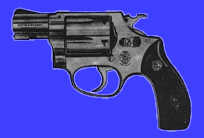 Cowley carried a Smith & Wesson .38 calibre weapon with a 2 inch barrel. One imagines a major factor in this choice is his lifestyle. As controller of CI5, he is usually called upon to wear business dress (and his taste seems to be for the close-fitting "Saville row" cut) and he spends a lot of time in the corridors of Whitewall negotiating with – or at least defending his corner from – the great and good. It would obviously be inappropriate for him to carry a heavy pistol which would run the risk of being seen beneath his suits. Additionally Cowley is middle-aged, wears spectacles and can no longer be regarded as a fully operative field agent. Therefore the number of occasions when he will be called upon to use the weapon will hopefully be minimal. It seems quite feasible that Major Cowley only carries the piece because the policy of the agency is for ALL personnel to be armed.
Cowley carried a Smith & Wesson .38 calibre weapon with a 2 inch barrel. One imagines a major factor in this choice is his lifestyle. As controller of CI5, he is usually called upon to wear business dress (and his taste seems to be for the close-fitting "Saville row" cut) and he spends a lot of time in the corridors of Whitewall negotiating with – or at least defending his corner from – the great and good. It would obviously be inappropriate for him to carry a heavy pistol which would run the risk of being seen beneath his suits. Additionally Cowley is middle-aged, wears spectacles and can no longer be regarded as a fully operative field agent. Therefore the number of occasions when he will be called upon to use the weapon will hopefully be minimal. It seems quite feasible that Major Cowley only carries the piece because the policy of the agency is for ALL personnel to be armed.
However on occasions when he is required to use it he seems quite effective. Notice his gunning down of the double agent in 'Need to Know'. Occassionally he seems to overestimate the potential of the smaller gun... he cannot really expect his revolver to reach the assassin in 'Killer with a Long Arm' with any accuracy and indeed if he was called upon to fire it at the apartment building he would just as likely hit Bodie or the rather nice young lady he has just "found"! Thankfully Major Cowley has used his skill as a strategian to great effect and had several years to plan for the case in 'Need to Know' so he brings along a high-powered rifle complete with telescopic sight.
His background in Military Intelligence have made Cowley realise the importance of planning and tactics. Perhaps he is familiar with Sun Tzu’s quote that a successful war is the one that is won before the fighting begins. He regards a weapon as a last resort and would rather out-maneouvre his opponents than risk a violent confrontation. The Major has an interest in weapons from a purely technical standpoint.He supports what he assumes to be his agents' interest in the custom weapon used in 'Killer with a Long Arm' and is quick to realise that the statistics they are referring to are not the muzzle velocity or performance parameters of the rifle or its sight (although frankly he would be hard-pressed not too) yet he is not too arrogant to bow to the expertise of others as in 'Foxhole on the Roof' when he recognises the description of a carbine yet asks Bodie to confirm his suspicions.
Paul Holloway adds the following: Being a revolver, it is quite fat to conceal well compared to a small, slender semi-automatic like a Walther PP or PPK (even though it is a 5 shot revolver to keep the cylinder diameter to a minimum). However, if Cowley had been a military officer prior to 1957, a .380 British calibre Enfield revolver was standard issue for many years until the FN Browning HP 9mm semi-automatic was standardised across the British armed forces in 1957. Being a "stick-in-the-mud", it makes perfect sense that he would stick to a .38 calibre revolver of some description for the rest of his career. In regard to accuracy, the .38 S&W Special round is exceptional, and despite the Model 36/37's short sight base, I would expect at best a 4" group at 50 metres, which is good enough to try for a headshot! Anything much over this distance would be more luck than judgement, only to be tried as a last resort.
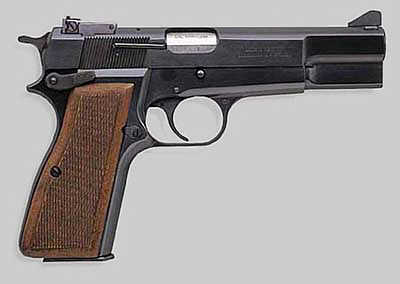 The Browning Hi-Power is regarded as one of the most successful of automatic pistols - and little wonder when it can carry thirteen 9mm rounds (plus "one up the spout", as Doyle seemed fond of saying!) It is/was used by the SAS who found it to be rugged and very reliable. Bodie and (especially) Doyle are often to be seen with this piece during the first two seasons. It's only downside is the requirement to thumb back the hammer prior to firing as it is a "single-action" trigger.
The Browning Hi-Power is regarded as one of the most successful of automatic pistols - and little wonder when it can carry thirteen 9mm rounds (plus "one up the spout", as Doyle seemed fond of saying!) It is/was used by the SAS who found it to be rugged and very reliable. Bodie and (especially) Doyle are often to be seen with this piece during the first two seasons. It's only downside is the requirement to thumb back the hammer prior to firing as it is a "single-action" trigger.
 The Walther P38 is another 9mm calibre weapon for Doyle. The moulding of the handgrip and the positioning of the safety catch makes operating difficult for left-handed shooters. The gun has an eight-round capacity, though an additional round can be loaded in the chamber as the safety design can be relied upon. The exposed barrel design means it is quite tolerant of poorly-manufactured ammunition. It is a very accurate gun and, therefore, good for long-distance shots. It would also be quicker than the Browning in getting a first shot off, as it has a "double action" trigger. This means that providing there is a 'round up the spout' (the Walther can safely do this), you need only to apply force to the trigger to cam back the hammer and fire the pistol. Once fired, the hammer will have been cocked by the cycling of the slide ready for the second shot on the more accurate "single action" of a smaller, lighter trigger pull, similar to the Browning. (Many thanks to David Miracky and Paul Holoway for info and corrections.)
The Walther P38 is another 9mm calibre weapon for Doyle. The moulding of the handgrip and the positioning of the safety catch makes operating difficult for left-handed shooters. The gun has an eight-round capacity, though an additional round can be loaded in the chamber as the safety design can be relied upon. The exposed barrel design means it is quite tolerant of poorly-manufactured ammunition. It is a very accurate gun and, therefore, good for long-distance shots. It would also be quicker than the Browning in getting a first shot off, as it has a "double action" trigger. This means that providing there is a 'round up the spout' (the Walther can safely do this), you need only to apply force to the trigger to cam back the hammer and fire the pistol. Once fired, the hammer will have been cocked by the cycling of the slide ready for the second shot on the more accurate "single action" of a smaller, lighter trigger pull, similar to the Browning. (Many thanks to David Miracky and Paul Holoway for info and corrections.)
From the 1979 episodes Bodie and Doyle mainly used a Magnum 357. Paul Holloway has this to say : Any pistol firing a .357 Magnum is impressive. The muzzle flash has been known to peel paintwork indoors! Being hit by one is life changing and probably fatal. The only disadvantage might be in a crowded situation where the .357 round could overpenetrate and hit an innocent person, behind your chosen target. Heavy recoil can be tamed by using a correct hold and training practice. The .357 Magnum is basically a lengthened .38 S&W Special round, and as such, any revolver that is chambered for the .357, can equally use the shorter, less powerful .38 S&W Special cartridge.
 The Python is Colt's top of the range piece. A six-shot revolver generating enough power to blast a round through two bodies! However this produces a huge recoil and near-deafening noise! Used by Doyle in 'Spy Probe', we think, though James Harris suggests it might actually be a Smith & Wesson Model 29 (as used by Clint Eastwood in the Dirty Harry movies.)
The Python is Colt's top of the range piece. A six-shot revolver generating enough power to blast a round through two bodies! However this produces a huge recoil and near-deafening noise! Used by Doyle in 'Spy Probe', we think, though James Harris suggests it might actually be a Smith & Wesson Model 29 (as used by Clint Eastwood in the Dirty Harry movies.)
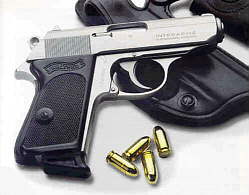 The Walther PPK was used, we believe, just twice: 'Long Shot' and 'Spy Probe'. An automatic equipped with a silencer attachment. The PPK is most commonly chambered for the 7.65mm Auto round, where it can carry seven rounds in the magazine plus one chambered. For security services the 9mm Short is a better choice as it hits harder than the 7.65mm. However, because the cartridges are that bit fatter, only six 9mm Short bullets can be carried in the magazine, plus the one extra chambered if required. This 9mm round is not the same as the 9mm Parabellum (9mm Luger) that the Browning or P38 uses, and it must be stressed that they are not interchangeable. Like the bigger brother Walther P38, the PPK also has a "double action" trigger to permit a fast first shot if required.The gun was favoured by many armed agencies (and, of course, a certain Mr James Bond!), though would eventually suffer metal fatigue, causing stoppages. This very nearly ended in disaster for Britain's Princess Anne when her bodyguard's PPK jammed during a hijack attempt in 1974. He took three bullets himself but miraculously survived. (Thanks to Paul Holloway)
The Walther PPK was used, we believe, just twice: 'Long Shot' and 'Spy Probe'. An automatic equipped with a silencer attachment. The PPK is most commonly chambered for the 7.65mm Auto round, where it can carry seven rounds in the magazine plus one chambered. For security services the 9mm Short is a better choice as it hits harder than the 7.65mm. However, because the cartridges are that bit fatter, only six 9mm Short bullets can be carried in the magazine, plus the one extra chambered if required. This 9mm round is not the same as the 9mm Parabellum (9mm Luger) that the Browning or P38 uses, and it must be stressed that they are not interchangeable. Like the bigger brother Walther P38, the PPK also has a "double action" trigger to permit a fast first shot if required.The gun was favoured by many armed agencies (and, of course, a certain Mr James Bond!), though would eventually suffer metal fatigue, causing stoppages. This very nearly ended in disaster for Britain's Princess Anne when her bodyguard's PPK jammed during a hijack attempt in 1974. He took three bullets himself but miraculously survived. (Thanks to Paul Holloway)
 The laser-sighted weapon seen in 'Hunter/Hunted', referred to as the "A-180", has caused a lot controversy amonst fans! It appears to be no more than a standard M16 rifle with a WW2 circular magazine taped on to it! In fairness genuine laser rifles were introduced around this time (so the story is realistic from that point of view) but probably would not have been made available for a mere television company to borrow! Ultimately, however, the military discovered that the lasers were not much use for long-range sniper work as they tended to frequently lose calibration - presumably the built-in power supplies were very "hungry" in those early days. Also, as hinted at in the episode, they were of little use to a soldier/sniper not wishing to give away his position. For close-quarters work, however, pistol versions proved useful - even if just to intimidate the opposition! (Thanks to Don Gresko and Austin Ruddy.)
The laser-sighted weapon seen in 'Hunter/Hunted', referred to as the "A-180", has caused a lot controversy amonst fans! It appears to be no more than a standard M16 rifle with a WW2 circular magazine taped on to it! In fairness genuine laser rifles were introduced around this time (so the story is realistic from that point of view) but probably would not have been made available for a mere television company to borrow! Ultimately, however, the military discovered that the lasers were not much use for long-range sniper work as they tended to frequently lose calibration - presumably the built-in power supplies were very "hungry" in those early days. Also, as hinted at in the episode, they were of little use to a soldier/sniper not wishing to give away his position. For close-quarters work, however, pistol versions proved useful - even if just to intimidate the opposition! (Thanks to Don Gresko and Austin Ruddy.)
However another contributor, "Chris", says the weapon seen in the episode is the "wrong shape [for an M16], even if you allow for the bolted on 'prop' bits. And the chances of a sniper rifle using .22 ammo seem slim. And most sniper rifles don't have a 'fully automatic' mode. Also you can clearly see the magazine underneath, so I'm not sure what the round black thing is supposed to be."
Fan Kari Korpi contributed a tremendous amount of info and thoughts on Bodie's favourite firearm: "A .22-calibre round would not be a great sniping round. Too little "oomph", although the Israelis do use suppressed Ruger 10/22 rifles as sniping rounds just because of their low damage potential (to knock people off their feet, say, with a shot to the leg, etc.) But the .22LR is definitely not "effective to 1,000 yards - at least" [as Cowley claims]. 100 yards, more likely!
"However, there is the question of just what .22-calibre round is used! The cartridge most people associate with .22 calibre would be the .22LR, but there are extremely high-velocity cartridges such as the .221 Fireball as well. Not to mention the old faithful 5.56mm NATO, which is .223-calibre.
"Second, there actually is a weapon called the AR-180, and it does use .22LR cartridges fed from a top-mounted drum magazine, like the funny-looking [one in this episode]. I believe it was licence-produced in Croatia or some such state."
"I looked at the rifle in the episode and it might be a "sexed-up" Armalite AR-18, which was licence-produced in the UK by Sterling. The AR-18 has a flat top receiver; I don't think it would be too hard to put the M16-type carrying handle and scope on top of it for prop purposes, since they did add all those funky bits like the drum or the laser projector below the barrel. The spent cases ejected by the weapon looked like 5.56mm NATO, and the single cartridge found on Brownie's boat looks like one as well.
"My main gripe about the ep is the "laser lock" system. For two reasons such a system would be useless in the sniper role. First, sniping is about shooting your enemy before he or his mates spot you. Projecting a huge red dot on his chest right where anyone can see it is stupid! [In fairness, the boys do mention this little flaw in the ep! -Dave] Second, if the "laser lock" was made to put the rounds where the laser pointed at by keeping the rifle constantly on target - no way! Even a .22LR recoils so much that the laser would jump off target unless some fancy gyro/gimbal work would be used, and even then it would be impossible for a human shooter to keep the barrel on target. A laser sight is most useful in close-combat assaults without a reflex sight, and even then a "tactical light" - really a torch below the gun barrel - was more useful because they could be seen better and had the chance of dazzling the target as well!"
Fan Michael Brown offered these insights: "There was in fact rifle called the 'American 180' in .22-calibre (ordinary .22 used for shooting rabbits and the like, not the more powerful .223/5.56mm M-16 round) for sale in the US in the late 1970s with a horizontal top-mounted drum magazine holding 177 .22-cal rounds. The “180” designation probably referred to the approximate [capacity of the] drum. There was a version available with a laser sight. The .22 round has an effective range of only about 100m, so it was certainly not a sniper rifle in the true sense. [However] the rifle used in the episode looks to me like an Armalite AR-10 with mock-up pieces (the “drum magazine”, scope and laser projector in particular) added."
"Nick" posted the following suggestions:
"The rifle is a modified AR10 with bolt on sight and 'prop' top magazine. This was another design from Eugene Stoner who made the AR15 (military designator M16) and the AR18 (no military sales). It was produced in small quantities and the major user was Portuguese colonial forces.
"Its calibre was NATO 7.62mm (or .308") and explains the size of the cartridge. Any other firearms expert would agree that the magazine under the weapon (which is in the Bodie and Doyle Photos) is a 20 round 7.62 magazine. This was another Eugene Stoner design and was a 'waffle' stamp for extra strength."
Finally an anonymous source submitted the following observations...
"It is actually an Armalite AR-10. The rifle is physically similar to the AR-15/M16 which is still used by the US army, but there are a number of little differences. The cocking handle is the most obvious one.
"This is an AR-10, albeit with a wooden, rather than plastic, stock and handguard.
"[The weapon seen in the episode shows a] distinctive 'flash hider' on the end of the muzzle. [And] note the carrying handle on which the rifle scope is mounted; there's a rotary dial which is used to adjust the 'iron sights' and a big curved cocking handle, neither of which are present on the AR15.
"In real life the AR-10 is a powerful rifle chambered for 7.62x51mm NATO ammunition and is popular as a hunting or target rifle in America. In theory, it fits the episode.
"The drum on the top is from a Thompson submachine-gun, [as can be seen here].
"As for the laser pointer, it seems pointless given that the rifle already has a telescopic sight. The dot would simply appear in the middle of the crosshairs, achieving nothing. In fact it would be a hindrance, because the pointer is fixed in line with the barrel; beyond a few dozen metres, the rifle has to be aimed slightly upwards in order to compensate for the bullet's trajectory, at which point the laser dot would be pointing above the impact point. At a thousand metres the laser would be completely off target.
"The odd thing is that the rifle seems to have been made up to look like the American 180, which is also mentioned on your page and isn't a sharpshooting rifle at all."
Despite the clear problems with the laser-sight, the 'Hunter/Hunted' does reflect reality in that the armed forces did indeed experiment with such a device in the late seventies.
Communications
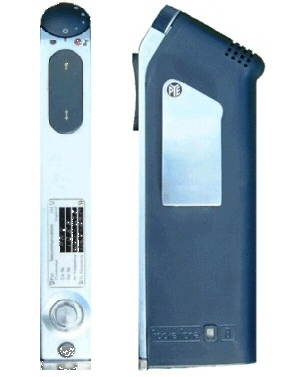 With the exception of a few early episodes, the walkie-talkies used in the show were Pye PF8s, considered to be an extremely good unit in their day, being used widely by the police.
With the exception of a few early episodes, the walkie-talkies used in the show were Pye PF8s, considered to be an extremely good unit in their day, being used widely by the police.
The radio actually has two microphones, selectable by the two-position 'Push To Talk' switch. The speaker grille actually acts as the antenna.
However, although a very stong, rugged design, they weren't particularly powerful. Generating only 0.5 watts of power and operating on the UHF band between 450-470MHz, you'd be lucky to achieve a reach of one mile - particularly in London! Nevertheless the same basic spec is still in use today. (Many thanks to Mike Burgess for pic and info!)
Wristwatches
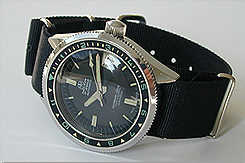 In the first season, Lewis and Martin wore what appears to be an Ollech & Wajs Caribbean 1000, a highly desirable military watch in the 70s (and much sought after by collectors today!) It was capable of hitting depths of 1000m (in comparison the Rolex Submariner of the time could only manage 200m) and had a unique feature that allowed the owner to easily replace the glass should it suffer damage in "battle". The model seen here features a different bracelet to the stainless steel one worn by both actors.
In the first season, Lewis and Martin wore what appears to be an Ollech & Wajs Caribbean 1000, a highly desirable military watch in the 70s (and much sought after by collectors today!) It was capable of hitting depths of 1000m (in comparison the Rolex Submariner of the time could only manage 200m) and had a unique feature that allowed the owner to easily replace the glass should it suffer damage in "battle". The model seen here features a different bracelet to the stainless steel one worn by both actors.
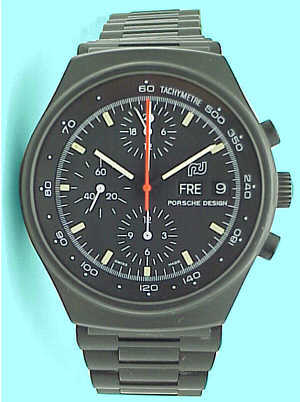 From the second season, Lewis wore Porsche Design's "PO11" chronograph wristwatch, as pictured here. (There is also a "Military" variant, which had the numerals 1 to 12 around the bezel instead.) A very popular timepiece (for those that could afford it!), also worn by Lew in Who Dares Wins and Chuck Norris & Lee Marvin in Delta Force. Martin wore a variant on the PO11 made by Orfina which although looks extremely similar, has the three small dials rearranged. In fact Martin and Lewis both appear to have kept their watches for several years after The Professionals finished. A super-tough design but the black anodised coating tends to peel off quite readily. Eterna reissued the Porsche variant as a 25th Anniversary Limited Edition (1,998) in 1998. The asking price? A mere 1200GBP!! To be honest they are outrageously overpriced! (Thanks to Stan Hendricks)
From the second season, Lewis wore Porsche Design's "PO11" chronograph wristwatch, as pictured here. (There is also a "Military" variant, which had the numerals 1 to 12 around the bezel instead.) A very popular timepiece (for those that could afford it!), also worn by Lew in Who Dares Wins and Chuck Norris & Lee Marvin in Delta Force. Martin wore a variant on the PO11 made by Orfina which although looks extremely similar, has the three small dials rearranged. In fact Martin and Lewis both appear to have kept their watches for several years after The Professionals finished. A super-tough design but the black anodised coating tends to peel off quite readily. Eterna reissued the Porsche variant as a 25th Anniversary Limited Edition (1,998) in 1998. The asking price? A mere 1200GBP!! To be honest they are outrageously overpriced! (Thanks to Stan Hendricks)
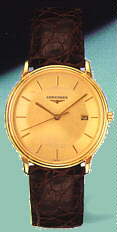 Throughout the series Gordon wore a Longines manual with second hand and date indication – very similar to the one pictured here. (Credit: James Harris)
Throughout the series Gordon wore a Longines manual with second hand and date indication – very similar to the one pictured here. (Credit: James Harris)
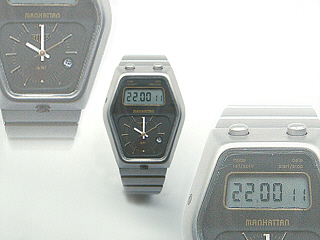 The watch that Bodie prizes so highly in 'Blackout' was a Heuer Manhattan - very similar to the one shown here.
The watch that Bodie prizes so highly in 'Blackout' was a Heuer Manhattan - very similar to the one shown here.
